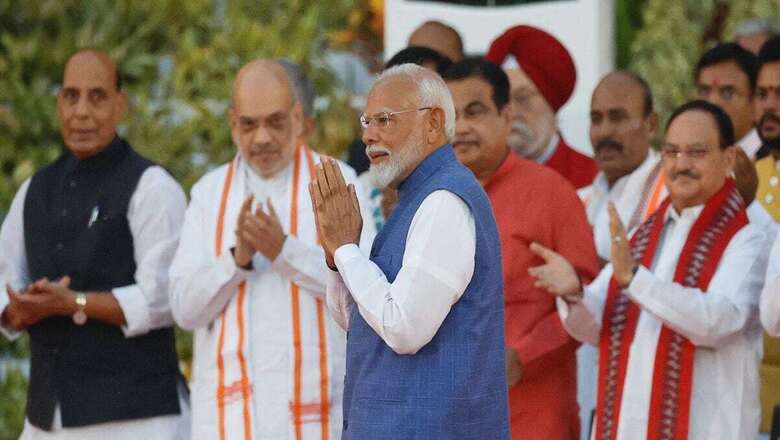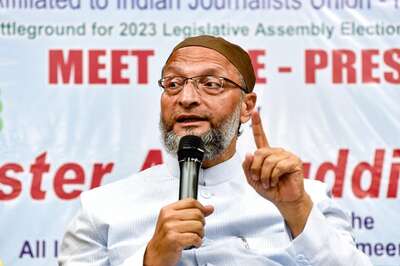
views
As Prime Minister Narendra Modi shared the stage with world leaders at the G7 Summit in Italy, it became amply clear how India stands as the lone exception across major democracies in delivering a clear mandate to the incumbent leader and government, since Covid. The Modi government has the unique distinction of being voted for the third consecutive time, for the first time in 62 years, since 1962. Modi 3.0, by 2028, will mean that Narendra Modi will become the longest-serving elected Prime Minister of India, overtaking Nehru.
In any case, Nehru was not elected but selected in his first term. Hence Modi’s three terms are unparalleled, in that sense. Better vote share in Punjab and Tamil Nadu, two states where the BJP had little presence, a seat, finally, in Kerala from Thrissur, but above all, the stellar debut of the BJP in the Odisha state assembly, with a brute majority, is a testament to Prime Minister Modi’s unrelenting popularity.
In Odisha, for instance, for the first time in more than two decades, we had a national party sweeping both the Lok Sabha and the state Assembly elections. In fact, in the last six months alone, the BJP under the aegis of Modi, has managed to form a government in six states on its own merit. In Madhya Pradesh, the BJP beat 18 years of anti-incumbency. Rajasthan, Chhattisgarh, Odisha, Andhra Pradesh and Arunachal Pradesh have given mandate to the BJP at the state level. The last time the Congress secured 240 seats in a general election was in 1984 and the last time the Congress scored over 230 seats in a Lok Sabha Election was in 1991 when it got a tally of 232. The party ran a coalition government with 145 odd seats in 2004 and yet again with 206 seats, it ran a coalition government in 2009 too. Hence the Congress has no locus standi whatsoever, to question the BJP which standalone won 240 seats in this year’s Lok Sabha elections. And this, despite being in power for ten long years from 2014-2024.
Modi’s extraordinary achievement of being elected for the third time in a row gets even bigger, when looked at in the larger global context where incumbents have seen their fortunes fading. For example, in the US, the incumbent President Donald Trump was voted out during the pandemic, in 2020. Current incumbent Joe Biden is trailing in opinion polls. In Indonesia, the incumbent coalition lost the Presidential elections in 2024 to the Great Indonesia Movement Party, better known as the Gerindra Party, by a wide margin. In Brazil, the incumbent President was voted out in 2022.
In Japan, the incumbent party managed to retain power in 2021 only after twice changing its prime ministerial candidates. In the Philippines, the incumbent vice president lost the Presidential elections in 2022 to the challenger. In Germany, the ruling coalition of the former incumbent chancellor recorded the worst-ever losses in 2021, making way for a new chancellor from a third party, which then emerged as the largest party after nearly two decades. In Thailand, in the general elections of 2023, the incumbent prime minister’s party lost vote shares and seats to multiple Opposition parties.
Similarly, in the United Kingdom, ahead of the general elections, the incumbent is trailing in the opinion polls. In France, the incumbent president was re-elected in 2022 after a face-off that saw no candidate getting a majority. In South Africa, the incumbent party, the ANC, lost majority in 2024 for the first time after 30 years of rule. In Colombia, the incumbent party lost the presidential elections in 2022 with the Opposition left-wing candidate winning for the first time. In South Korea, the incumbent party’s presidential candidate lost in 2022 to the Opposition party’s presidential candidate. In Spain, no single party gained a majority in the 2023 general elections after the incumbent party in power finished second, behind the Opposition party, in both seats and vote share.
Speaking of the Modi 3.0 cabinet, it is a dynamic blend of both continuity and change. The Cabinet Committee on Security (CCS) retained its existing lineup, with Rajnath Singh, Amit Shah, Nirmala Sitharaman, and S Jaishankar holding onto their roles in defence, home, finance, and external affairs, respectively. Nitin Gadkari has also been retained as Minister of Road Transport and Highways. Prime Minister Modi will be in charge of the Ministry of Personnel, Public Grievances and Pensions, the Department of Atomic Energy, the Department of Space, all important policy issues, and all other portfolios not allocated to any minister.
Regarding new appointments, former Madhya Pradesh Chief Minister Shivraj Singh Chouhan will take on responsibilities in agriculture and rural development, while BJP President JP Nadda returns to the health ministry, a position he held in Modi 1.0. Kinjarapu Ram Mohan Naidu (TDP), Minister of Civil Aviation; Chirag Paswan (LJP), Minister of Food Processing Industries; HD Kumaraswamy (JD[S]), Minister of Heavy Industries and Minister of Steel; and Jitan Ram Manjhi (HAM), Minister of Micro Small and Medium Enterprises, are some of the key alliance partners with their equally heavyweight portfolios, who figure in the Modi 3.0 cabinet. 71 ministers officially joined the Modi 3.0 cabinet. They, along with Prime Minister Narendra Modi, took their oaths during an impressive swearing-in ceremony on June 9, 2024.
Clearly, Modi’s third innings as Prime Minister has begun with a diverse and inclusive team representing at least 24 states and union territories across India. Uttar Pradesh, for instance, is well-represented with nine ministers in the cabinet including Rajnath Singh, Hardeep Singh Puri, Pankaj Chaudhry, Anupriya Patel, Jitin Prasad, Jayant Choudhary, B.L. Verma, Kamlesh Paswan, and S.P. Singh Baghel. Bihar too has good representation with eight ministers, reflecting the need to balance interests with allies JDU and LJP. Prominent ministers from Bihar include Chirag Paswan, Giriraj Singh, and Lalan Singh. West Bengal has two ministers, Shantanu Thakur and Sukanta Majumdar. Tamil Nadu saw L. Murugan being retained in the cabinet. From Punjab, Ravneet Singh Bittu has been appointed as a minister.
The new Modi cabinet has a mix of highly experienced names and young blood too, giving it just the right touch of dynamism, political acumen and strategic genius that a coalition government should be all about. The inclusion of stalwarts like Shivraj Singh Chouhan signals a holistic embrace of the Rashtriya Swayamsevak Sangh’s satraps, ensuring that the party’s ideological roots are well preserved, contrary to unwanted noise about a rift between the RSS and the BJP doing the rounds in the media. Simultaneously, the appointment of leaders like Chirag Paswan underscores a practical approach to coalition politics, emphasising the need for strong alliances, young blood and a fresh approach to realpolitik.
Modi 3.0 is not just about deft navigation of the emerging political terrain; it is a nuanced balance of raj dharma and coalition dharma, where PM Modi is inevitably guided by the need for political and macro-economic stability and good governance. The BJP, while undeterred in its ideological moorings, now leads a coalition that is a mosaic of varied parties. This diversity is, however, a strength and not a weakness as the allies are not united by any narrow, opportunistic motives. Chances of any discord are limited because under the visionary leadership of Modi, despite disagreements, if any, the overriding ambition and desire to work for the greater common good shall prevail.
The Modi 3.0 cabinet, therefore, represents a strategic collaboration that combines political wisdom with the art of the possible. It is a coalition based on conciliation and consensus, not confrontation or compulsion, with PM Modi steering India towards a future that is both promising and aspirational.
The BJP’s understanding that a government with natural allies such as the Telugu Desam Party (TDP), Janata Dal [United] (JD[U]), Jana Sena, and Janata Dal [Secular] (JDS) requires a nimble, surefooted anchor, is astute. At least 34 out of the 71 cabinet ministers have 30 years of experience, maybe more, in active politics, serving as a strong bulwark against any imminent or potential ideological dilution. Clearly, the Modi 3.0 cabinet is a testament to the BJP’s sharp foresight, with a willingness to include diverse perspectives of coalition partners, which is crucial for the stability and longevity of the government. And yet, it has the inimitable Modi stamp written all over it.
This is a subtle signal that while the BJP is willing to evolve, compromise, adapt and accommodate, it does not intend to discard the ideological commitments that have been the cornerstone of its political journey, from a party of just 2 seats in the 1980s to becoming the political behemoth that it has become today, in 2024.
The party’s agenda and the government’s priorities are harmoniously intertwined, with the cabinet serving as the institutional mechanism for PM Modi’s vision of Viksit Bharat by 2047. In this new cabinet, the BJP has allocated 30 berths to cabinet ministers; there are 5 ministers of state with independent charge, and 36 ministers of state, totalling 71 members. This number includes 11 ministers from NDA partners, signifying a solid 15 per cent share of cabinet berths to allies. The distribution of ministerial roles among allies like the TDP and JD(U) is a strategic move that underscores the BJP’s intent to foster a collaborative environment under the current circumstances. The number of berths given to different partners and their significance goes beyond mere numbers; it is about giving due respect to the coalition partners’ regional and national aspirations, something which a seasoned leader like Modi understands only too well.
The formation of Modi 3.0, a blend of seasoned stalwarts and fresh faces, is a reflection of the BJP’s dual commitment to effective governance and rewarding the party’s loyal cadre who have risen up the ranks. Modi 3.0 has set a formidable agenda with a focus on achieving key goals within the first 100 days. This ambitious plan underlines the Modi government’s commitment to rapid development and reforms. The targets, which include making India a $5 trillion economy by 2026-27 and a developed nation by 2047, reflect a forward-looking vision that seeks to catapult India onto the world stage as an economic superpower.
This delicate balance between rewarding loyalty and focusing on governance defines Modi 3.0, setting the stage for a tenure that is as much about fulfilling the party’s ideological commitments as it is about steering the nation toward its developmental goals. The message is clear: the BJP remains committed to its roots, while forging ahead with a clear vision for India’s future.
The success of Modi 3.0 will depend not just on its policy prowess but on its ability to smoothen rough edges, if any, say political pundits. However, these political pundits forget that PM Modi is very much his own person, extremely comfortable in his own skin. Modi is passionately firm about his stand on key issues that matter, and is yet never averse to listening to diverse opinions or imbibing what works for the greater good, even if that entails making small sacrifices in the process. And that precisely is what makes Narendra Modi who he is—a towering tall persona whose style of politics is not only shaping the destiny of 1.4 billion Indians but also making a huge impact on global geopolitics.
Modi has turned anti-incumbency into pro-incumbency and this is due to his untiring ability to constantly reinvent himself, while his opponents continue to grapple with being fringe players. The 139-year-old Congress party could not even touch 100 seats and the INDI alliance was contained at 234 seats in the 2024 general elections. In sharp contrast, the Modi juggernaut emerged unscathed, pretty much holding its own. If numbers mean what they do, then sample this– in the last three Lok Sabha elections put together, the tally of the Congress from Uttar Pradesh is a mere nine seats. On the contrary, that number from UP, for the BJP in the last three Lok Sabha elections combined, is a staggering 170 seats.
Politics is not just about momentum but a proven track record too. In the case of Prime Minister Modi, he has both momentum and an excellent track record working to his advantage. Add to that his consistency in delivering on electoral promises, and what you have is a lethal combination in terms of a leader who knows his mind, knows what to do and more importantly, how to do it, so that an aspirational India becomes a reality.
Sanju Verma is an Economist, National Spokesperson for BJP and Bestselling Author of “The Modi Gambit”. Views expressed in the above piece are personal and solely those of the author. They do not necessarily reflect News18’s views.

















Comments
0 comment